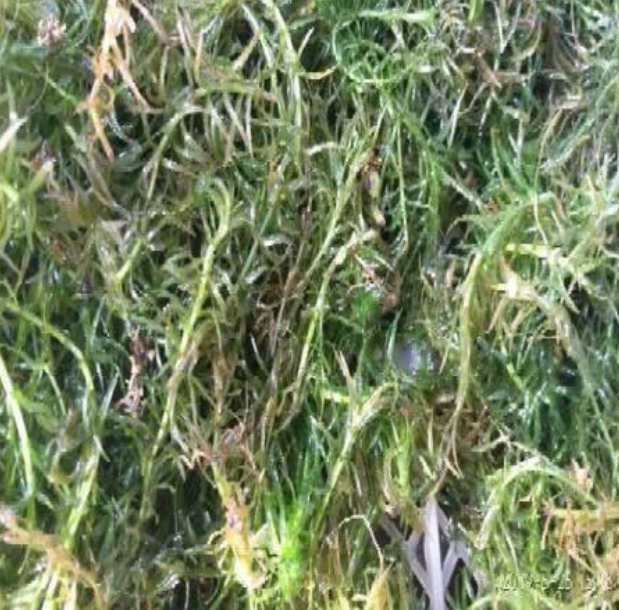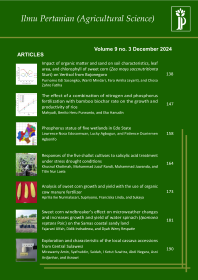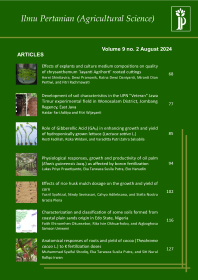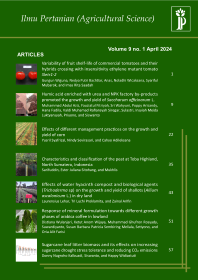
The role of hydrilla (Hydrilla verticillata (L.f.) Royle) as soil protectant in improving soil physical, chemical, and biological properties
Dyah Roeswitawati(1), Zamzami Faizal Ahmad(2*), Machmudi Machmudi(3)
(1) Agrotechnology Department, University of Muhammadiyah Malang Jl. Raya Tlogo Mas No. 246 Malang 65144, East Java, Indonesia
(2) Agrotechnology Department, University of Muhammadiyah Malang Jl. Raya Tlogo Mas No. 246 Malang 65144, East Java, Indonesia
(3) Agrotechnology Department, University of Muhammadiyah Malang Jl. Raya Tlogo Mas No. 246 Malang 65144, East Java, Indonesia
(*) Corresponding Author
Abstract
Keywords
Full Text:
PDFReferences
Ayaz, M., Feiziene, D., Tilvikiene, V., Akhtar, K., Stulpinaite, U. , and Iqbal, R. (2021). Biochar role in the sustainable of agriculture and environment. Sustainability, 13(3), 1330.
Fasya, A.G., Amalia, S., Megawati, D.S., Salima, F., Kusuma, V.A., Purwantoro, B. (2020). Isolation, identification, and bioactivity of steroids isolates from Hydrilla verticillata petroleum ether fraction. Conference Proceedings. IOP Conference Series: Earth and Environmental Science, 456, 012009.
Fuad, M.T., Aunurohim, and Nurhidayati, T. (2013). Efektifitas kombinasi Salvinia molesta dengan Hydrilla verticillata dalam remediasi logam Cu pada limbah electroplating. Jurnal Sains dan Seni Pomits, 2(1), pp. 240–245.
Garg, N. and Chandel, S. (2010). Arbuscular mycorrhizal network: process and functions. A review. Agronomy for Sustainable Development, (30), pp. 581–599.
Gettys, L.A. and Leon, R.G. (2021). A population genetics approach for the study of fluridone resistance in hydrilla. Aquatic Invasions, 16(1), pp. 28–42.
Hang, E.J., Harris, J.T., and Richardson, R.J. (2019). Monoeceous Hydrilla verticillata development in complete darkness. Aquatic Botany, 154, pp. 28–34.
Hang, Q., Wang, H., He, Z., Dong, W., Chu, Z., Ling, Y., Yan, G., Chang, Y., and C. Li, C. 2020. Hydrilla verticillata sulfur-based heterotrophic and autotrophic denitrification process for nitraterich agricultural runoff treatment. International Journal of Environmental Research and Public Health, 17(5), 1574.
Jain, M.S. and Kalamdhad, A.S. (2018a). A review on management of Hydrilla verticillata and its utilization as potential nitrogen-rich biomass for compost or biogas production. Bioresource Technology Report, 1, pp. 69–78.
Jain, M.S. and Kalamdhad, A.S. (2018b). Efficacy of batch mode rotary drum composter for management of aquatic weed (Hydrilla verticillata (L.f.) Royle). Journal of Environmental Management, 221, pp. 20–27.
Jain, M.S. and Kalamdhad, A.S. (2019). Drum composting of nitrogen-rich Hydrilla verticillata with carbonrich agents: Effects on composting physics and kinetics. Journal of Environment Management, 231, pp. 770–779.
Jain, M.S., Daga, M., and Kalamdhad, A.S. (2019). Variation in the key indication during composting of municipal solid organic wastes. Sustainable Environment Research, 29, 9.
Kane, J.L. (2019). Soil microbial succession following surface mining is governed primarily by deterministic factors. Thesis. West Virginia University. Kara, Y. (2005). Bioaccumulation of Cu, Zn, and Ni from the wastewater by treated Nasturtium officinale. International Journal of Environment Science and Technology, 2(1), pp. 63–67.
Khatoon, H., Solanki, P., Narayan, M., Tewari, L., and Rai, J.P.N. (2017). Role of microbes in organic carbon decomposition of soil ecosystem. International Journal of Chemical Studies, 5(6), pp. 1648–1656.
Lafabrie, C., Major, K.M., Major, C.S. and Cebrian, J. (2013). Trace metal contamination of the aquatic plant Hydrilla verticillata and associated sediment in a Costal alabama Creek (Gulf of Mexico-USA). Marine Pollution Buletin, 68(1–2), pp. 147–151.
Marwan, Haruna, N., and Yasin, S.M. (2017). Pemanfaatan Hydrilla verticillata (L.f) Royle sebagai pupuk hijau untuk memacu pertumbuhan bibit cacao (Theobroma cacao L.). Journal TABARO, 1(1), pp. 1–10.
Mosaic Agri Sight. (2021). Five benefits of soil organic matter. [Online] Available at: https://www. cropnutrition.com/resource-library/fivebenefits-of-soil-organic-matter [Accessed 24 Desember 2021].
Roeswitawati, D., Sari, S. F. I., Sukorini, H. (2018). Respon varietas sawi (Brassica sinensis) terhadap bahan mikroorganisme lokal (MOL): bonggol pisang, limbah buah dan limbah sayur. Prosiding Sem.Nas. FP UNS, 2(1), pp. 40–48.
Roeswitawati, D., Ningsih, Y.U., and Muhidin. (2019). The effect of local microorganism (MOL) concentration of banana hump and fruit waste on the growth and yield of broccoli plants (Brassica oleracea). 4th International Conference on Food and Agriculture Resources (FANRes 2018) Advances in Engineering Research, (172), pp. 310–314.
Safitri, R.D., Nugroho, A., Fitrial, Y., and Fatmawati. (2019). Pemanfaatan rumput air (Hydrilla verticillata) sebagai kompos pada bunga kol (Brassica oleracea). EnviroScienteae, 15(2), pp. 257–262.
Sharma, R., Sharma, K., Singh, N., and Kumar, A. (2013). Rhizosphere biology of aquatic microbes in order to access their bioremediation potential along with different aquatic macrophytes. Recent Research in Science and Technology, 5(1), pp. 29–32.
Shi, D., Zhuang, K., Chen,Y., Hu, Z., and Shen, Z. (2021). Phytotoxicity and accumulation of Cu in mature and young leaves of submerged macrophyte Hydrilla verticillata (L.f.) Royle. Ecotoxicology and Environment Safety, 208, 111684.
Shiga, T., Khaliunaa, K., Baasanmunkh, S., Oyuntsetneg, B., Midorikawa, S., and Choi, H.J. (2020). New mongolian records of two genera, seven species, and two hybrid nothospecies from Khar-US lake and its associated wetlands. Journal of AsiaPasific Biodiversity, 13(3), pp. 443–453.
Shrivastava, M. and Shrivastava, S. (2021). Application and research progress of Hydrilla verticillata in ecological restoration of water contaminated with metals and metalloids. Environmental Challenge, 4, 100177.
Si, T., Chen, H., Qiu, Z., Zhang, L., Ohore, O.E., and Zhang, S. (2020). Bacterial succession in epiphytic biofilms and deciduous layer sediments during Hydrilla verticillata decay: A field investigation. Journal of Environmental Sciences, 93, pp. 193–201.
Srivastava, S., Bhainsa, K.C., and D’Souza, S.F. (2010). Investigation of uranium accumulation potential and biochemical responses of an aquatic weed Hydrilla verticillata (L.f.) Royle. Bioresource Technology, 101(8), pp. 2573–2579.
Venkateswarlu, V., Venkatrayulu, C., and Bai, T.J.L. (2019). Phytoremediation of heavy metal copper (II) from equeous environment by using aquatic macrophytes Hydrilla verticillata and Pistia startiotes. Int. Journal of Fisheries and Aquatic Studies, 7(4), pp. 390–393.
Sousa, W.T.Z., Thomaz, S.M., and Murphy, K.J. (2010). Response of native Egeria najas Planch and invasive Hydrilla verticillata (L.f.) Royle to altered hydroecological in a subtropical river. Aquatic Botany, 92(1), pp. 40–48.
Yavitt, J.B., Pipes, G.T., Olmos, E.C., Zhang, J., and Shapleigh, J.P. (2021). Soil organic matter, soil structure, and bacterial community structure in a post agricultural landscape. Frontiers in Earth Science, 9, 590103.
Zhao, B., Xing, P., and Wu, Q. L. (2017). Microbes participated in macrophyte leaf litters decomposition in freshwater habitat. FEMS Microbiology Ecology, 93(10), pp. 1–15.
Zhong, G., Wu, Z., Yin, J., and Chai, L. (2018). Responses of Hydrilla verticillata (L.f.) Royle and Vallesneria natans (Lour) Hara to glyphosate exposure. Chemosphere, 193, pp. 385–393.
Article Metrics
Refbacks
- There are currently no refbacks.
Ilmu Pertanian (Agricultural Science) ISSN 0126-4214 (print), ISSN 2527-7162 (online) is published by Faculty of Agriculture Universitas Gadjah Mada collaboration with Perhimpunan Sarjana Pertanian Indonesia (PISPI) and licensed under a Creative Commons Attribution-ShareAlike 4.0 International License.













